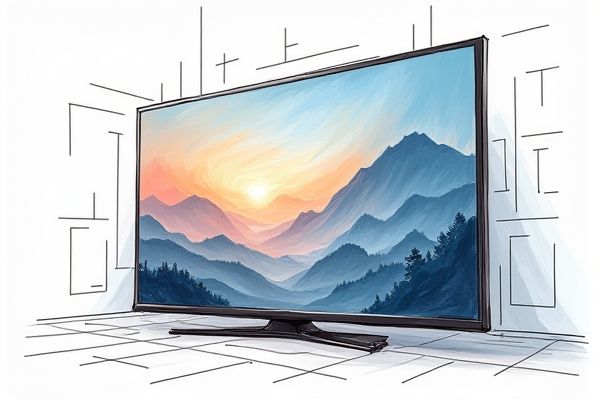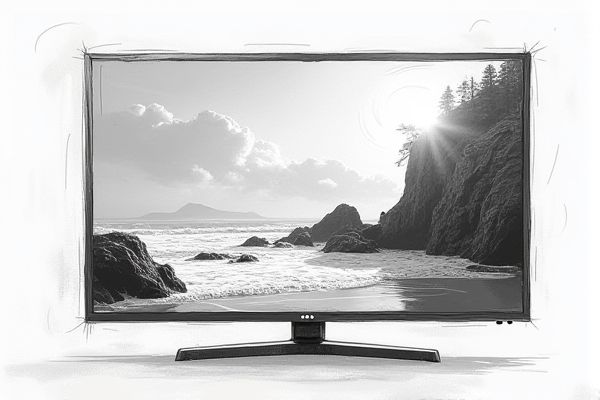As technology advances, smart TVs have become an integral part of modern homes, offering an unparalleled viewing experience combined with seamless connectivity. India, being a rapidly growing market, hosts a variety of brands that cater to diverse customer preferences and budgets. Brands like Samsung and LG have long been recognized for their high-quality displays and robust features, while Xiaomi and OnePlus offer competitive pricing without compromising on technology. For a comprehensive look at the best smart TV brands in India, continue reading below.

Illustration of smart tv in india
Best brands of smart tv in india in 2025
Samsung
Samsung has emerged as a leading producer of smart TVs in India, overtaking Xiaomi in the first quarter of 2024 with a 40% increase in shipments, capturing 16% of the market share. This growth is attributed to the company's innovative products, such as its Neo QLED TVs and Bespoke customizable TVs, which have resonated well with consumers. According to a Counterpoint Research report, Samsung's strong performance helped it gain the top slot, while LG followed closely with a 43% growth and a 15% market share. The Indian smart TV market, despite a 14% decline in overall shipments, saw Samsung and LG drive growth in the premium and larger screen segments. For more information on Samsung's cutting-edge smart TVs, visit their official TV product page.
LG
LG is a prominent player in the Indian smart TV market, holding a significant market share. In the first quarter of 2024, LG increased its shipments by 43%, securing a 15% market share, making it the second-largest player in the market. LG's Nano Cell and OLED TVs are gaining popularity, and the company has introduced new models in the 32-inch segment, contributing to its market growth. With a 10% share in the Indian smart TV market, LG continues to innovate with technologies like nanotechnology and quantum dot, enhancing picture quality. LG's strategic offerings, including rebates and free product insurance, have also boosted its sales.
Sony
Sony is a leading brand in the Indian smart TV market, renowned for its premium and high-quality products. In the 2023-24 fiscal year, Sony India recorded a 21% growth, with a significant market share in the premium TV segment, particularly in 55-inch and above screen sizes where it holds around 35% market share. Sony also saw a 19% increase in smart TV shipments in the first quarter of 2024 compared to the previous year, securing a joint fourth position in the market with a 7% share. The company dominates the 85-inch, 75-inch, and 65-inch screen categories with market shares of 49%, 45%, and 36%, respectively. Sony's strong performance is driven by its innovative products and growing consumer demand for premium electronics.
Xiaomi
Xiaomi, often referred to as Mi, has been a dominant force in the Indian smart TV market, holding a significant market share. As of the first half of 2023, Xiaomi led the market with a 14% share, followed by its strong presence in the HD and FHD segments with a 23% market share. The brand's popularity is attributed to its affordable and feature-rich TV models, such as the Redmi and 5A series, which are available for under $200 USD. Xiaomi's smart TVs, especially those with 8GB internal storage, have seen a notable increase in sales, contributing to the brand's market leadership. However, recent reports indicate that Samsung has overtaken Xiaomi in the Indian smart TV market due to a decline in shipments from Chinese brands. For more insights, visit the detailed analysis of the Indian smart TV market.
OnePlus
OnePlus was once a significant player in the Indian smart TV market, achieving remarkable growth with a 123% year-over-year increase in shipments in the first half of 2022, securing the third spot in the market. The brand's TV Y1, Y1S, and Y1S Pro models were among the top-selling smart TVs, with OnePlus holding a 7% market share in the first half of 2023. Despite this success, OnePlus has decided to exit the TV market in India, focusing instead on its smartphone business. The brand's TVs were popular in the sub-Rs 30,000 price segment, with the Y Series driving significant volume sales. However, Xiaomi remained the market leader with a 14% share in the same period. More details about OnePlus's exit from the Indian TV market can be found in the report.
TCL
TCL is a leading brand in the Indian smart TV market, known for its innovative and premium TV offerings. In 2024, TCL maintained its global position as the second-largest TV brand, with a 12.5% market share and 25.26 million units shipped. Despite a 4% decline in shipments in India's Q1 2024, TCL remains a significant player, sharing 7% of the market alongside Sony. TCL's success is driven by its advanced Mini LED technologies and high-end models, such as the QM8 series, which boasts up to 5,000 local dimming zones and a peak brightness of 5,000 nits. The brand's commitment to innovation and quality has made it a preferred choice for consumers seeking advanced features at competitive prices.
Panasonic
Panasonic is a significant player in the India smart TV market, known for its high-quality products and innovative features. In 2023, Panasonic, along with other key players like LG, Samsung, and Sony, contributed to the market's growth, driven by increasing disposable income and the rising popularity of OTT services. The India smart TV market, valued at USD 9.88 billion in 2022, is expected to expand at a CAGR of 16.7% from 2023 to 2030. Panasonic's offerings, including their advanced LED/LCD TVs, have been well-received in the Indian market, which saw a significant rise in TV penetration to 69% by the end of 2023. The brand's strategic promotions and online sales have further boosted its presence in the market.
Vu
Vu Televisions has established itself as a leading and innovative TV brand in India, doubling its market share in Q2 2022 to achieve a 5% market share. The company shipped over 120,000 TVs during the quarter and saw significant growth in Q3 2022, with smart TV shipments increasing by 38% and accounting for 22% of overall shipments. The successful launch of the Vu GloLED series, featuring a 4K display, Google TV connectivity, and a built-in subwoofer with 104 W sound output, contributed to this growth. In just two months, Vu sold 46,675 units of the GloLED TV, with a projected sale of 2 lakh units in 2023. This success is a testament to the company's dedication to providing technologically advanced products.
Hisense
Hisense is emerging as a significant player in the Indian smart TV market, driven by its aggressive expansion plans, including the establishment of over 1,000 product experience zones and partnerships with top distributors and retailers. In 2023, Hisense ranked second globally in TV shipments and held the top position for 100-inch TV shipments, according to OMDIA's global TV report. The company is set to launch a new lineup of 2024 TV models, including the flagship 100-inch Q7N QLED TV, to cater to diverse consumer preferences. Hisense's global high-end TV market share reached 24% in Q3 2024, with a notable increase in Mini LED TV shipments. This strategic expansion underscores Hisense's dedication to innovation, affordability, and strategic partnerships in the Indian market. For more details on Hisense's expansion plans in India, visit BizzBuzz News.
Philips
Philips, through its licensee TPV Technology, is making a significant comeback in the Indian smart TV market, aiming to capture a 6 to 8% market share by leveraging its high brand value among Indian consumers. Since 2018, Philips has introduced several models, including OLED TVs, and has partnered with Dixon Technologies for local assembly. The company plans to expand its service centers from 200 to 500 by the end of the year. Philips' strategy includes utilizing its existing retail network across over 35,000 stores and more than 200 distributors. This approach is expected to enhance its market presence and competitiveness in the Indian smart TV sector. For more details, read about Philips' comeback into the Indian market.
















Leave a Reply
Your email address will not be published.